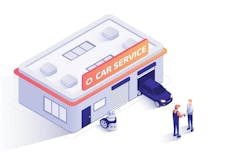This might not go to print until August, but I’m writing it in July so I’m going to borrow an idea from a mentor of mine and the guy who used to occupy this space: Mike Anderson, owner of Collision Advice. He is one of the most passionate people in our industry and has been helping shops become better operators for over 20 years. He is one-of-a-kind and cannot be mimicked or imitated, even though I’m going to attempt that impossible feat right now.
Mike started off with his wish list each January. While it’s the middle of the calendar year, we are all experiencing a new normal, so I figured no time like the present. Call it a “Christmas in July” top 10 wishes for our industry.
While I could pick many more items to include on this list, I picked what was top of mind most days. 2020 is going to be remembered for many things, and most people have felt helpless over the past several months. The good news is half of this wish list is completely in our control.
1) Increasing the labor rates: It’s time we get reimbursed for the specialized and difficult work we do. Every vehicle we get in our shops is uniquely hit. We also work on computers on wheels, so we could be compared with the tech’s who handle our IT. The first step in making this happen is to ask for what we deserve. We won’t get what we don’t ask for.
2. More available online technician training: We’ve finally arrived at a place in our industry where shops are willing to train their technicians. One of the best things to come out of the COVID-19 pandemic is companies improved their abilities to reach people remotely. While I appreciate the third parties that are offering this now, it’s time for the manufacturers to jump in with both feet. They want us to protect their brand and we need their help.
3. One-hundred percent compliance with following OE procedures: We have a long road to accomplish this. OE websites are the best and, (should be) only, place to access these procedures. Vehicles have changed drastically; it’s time we change with them.
4. Miles driven return to pre-pandemic levels: There are predictions that July’s miles driven will be 130 percent compared to recent history. Reasons given are people will be hesitant to get on planes or cruises, so they will get in their cars and drive to their destinations. Like other industries across the country, we have felt the impact of the shutdown. Here’s hoping that things will continue to open up and people get back on the road.
5. ADAS features to get uniform names: Currently the OEs are trying to differentiate themselves from competition by providing unique names to certain ADAS features even though the hardware in their vehicles are identical. The wheels are in motion on this, but it could use more support from our industry. It’s one thing when a “fender liner” is also called a “splash shield” or a “skirt”. But ADAS features are critical to the safety of those on and near the road. Having them named the same across different manufacturers would be a big step in helping us understand the functionality of those features.
6. All insurance companies allowing direct importing into CCC: Those who remember the days of rekeying each estimate can still feel the pain of doing such mind-numbing work. While we have come a long way, there are still a few companies that don’t allow this to happen and it should change immediately.
7. Aftermarket parts to disappear: In 22 years, we’ve installed three aftermarket parts and they all failed before the vehicle left the shop. I know they help keep the OE list price in check, but if our goal is to put the vehicle back into pre-accident condition, we should replace apples with apples. Aftermarket parts are in no way like, kind, or quality.
8. New reports from CCC: As they have arguably developed the best management system in the industry, most shop operators agree they are still lacking in providing some crucial reports. Most reports we want use data they already collect, but we still don’t have the option to configure reports from that data. Knowing how much work was completed, not delivered, is top on that list.
9. Office staff and techs come together: A successful shop is one where the dividing wall between the techs and the office staff disappears. We must realize we are on the same team. No one wins unless we all win. We are moving in the right direction, but there is still work left to do.
10. Respect for our industry: While most of us want this to come from the outside, it must start internally. It’s time we start acting like the professionals we’ve become. We are highly skilled teams working on technological marvels. The next couple of years will bring so much new technology that it will be time for us to wear lab coats while we repair “computers on wheels”. Outsiders will not start respecting our industry until we begin respecting ourselves and our competitors.
